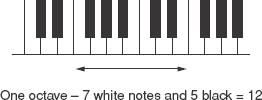2 Hearing and the nature of sound
Part 2
Pitch
We said earlier that the frequency ratio between two adjacent semitones was approximately 6%. In scientific (but not necessarily musical) terms, the exact number is
12![]() 2 (the twelfth root of 2)
2 (the twelfth root of 2)
This is the number which, multiplied by itself 12 times, equals 2 and is 1.0594631. A pitch change of one semitone is therefore equivalent to a frequency change of 5.94631%. (Six per cent is a good enough approximation for most purposes!)
The reasoning behind the mathematics is that there are 12 equal semitone ‘intervals’ in an octave, which itself is a frequency ratio of 2:1. Each step must therefore be 12![]() 2.
2.
The interested reader with a scientific calculator might try entering 1.0594631 into the calculator's memory and then using Memory Recall 12 times in the following way:
MR × 1.0594631 = 1.122462
MR × 1.122462 = ... and so on, a total of 12 times.
The final result will be 2, or something very close indeed to it, depending on the calculator.
Frequency ranges in music
Table 2.3 gives the approximate ranges of fundamental frequencies of a few musical sounds. The range from lowest to highest notes is often termed the compass of the instrument or voice. In each case the harmonics will extend the upper frequency, in some cases very considerably.
‘False bass’
This is the name given to an interesting effect by which the ear/brain system can somehow seem to insert very low frequencies which ought to be present but which are not reproduced. It may be that the brain recognizes a series of harmonics as being based upon a particular frequency and mentally compensates for this frequency if it is not present.
To take an example, Table 2.3 shows that the lowest pitch notes from a large pipe organ may be as low as 15 Hz. There are very few loudspeakers which can reproduce frequencies that low, and yet our ears are not generally aware of this deficiency.
Table 2.3 Approximate frequency ranges of musical sounds
Source |
Frequency (Hz) | |
|
from |
to |
Female singer |
250 |
1000 |
Male singer |
100 |
350 |
Flute |
250 |
2500 |
Bassoon |
60 |
600 |
Alto saxophone |
125 |
650 |
Trumpet |
200 |
1000 |
Violin |
200 |
3500 |
Cello |
70 |
600 |
Piano |
30 |
4000 |
Pipe organ (large) |
15 |
8000 |
Xylophone |
700 |
4000 |
Questions
1. Decibels could be appropriate to use for comparison in two of the following. Which two?
a. Two frequencies |
b. Two sound pressures |
c. Two loudnesses |
d. Two fundamentals |
e. Two powers |
f. Two loudspeakers |
2. A note has a frequency of 200 Hz. What is the frequency of the note an octave above?
a. 212 Hz |
b. 300 Hz |
c. 400 Hz |
d. 2000 Hz |
3. And what would be the frequency of a note an octave below?
a. 10 Hz |
b. 50 Hz |
c. 100 Hz |
d. 188 Hz |

